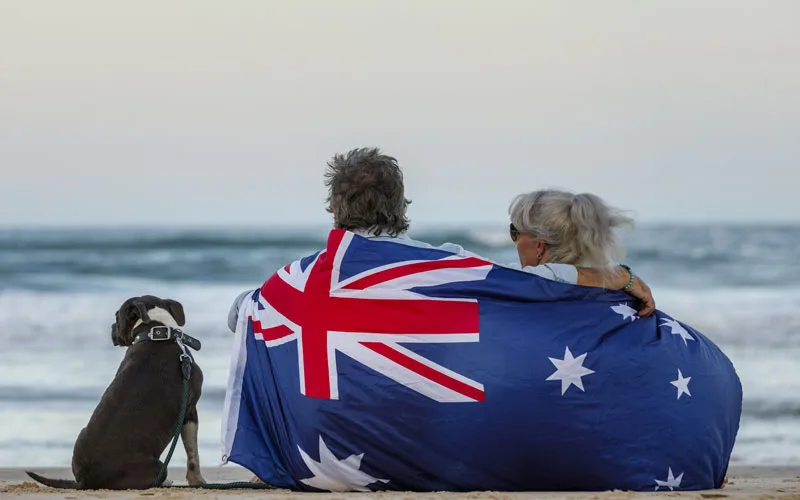On This Page...
ToggleIntroduction: Why This Guide Exists
After decades of helping thousands of couples apply for partner visas — across every relationship type, background, and visa complication — I’ve learned one hard truth: most people don’t fully understand what they’re walking into. And that’s not their fault. The process is complex, the stakes are high, and the rules aren’t always clear. But getting it wrong can cost more than just time and money. It can cost your future together.
This guide is for couples who are trying to stay together in Australia through the de facto partner visa process. Whether you’re same-sex or opposite-sex, married or unmarried, living together or long distance — this is your roadmap. It’s written in plain English and built on more than 25 years of experience advising on real cases, in real-life situations.
We’ll cover the key questions you probably already have — and more importantly, I’ll answer the ones you didn’t even know to ask.
I want this to be the most accurate, up-to-date, and useful guide available. So if you come across anything in this article that needs clarification or updating, please reach out. It won’t just help me — it will help our whole community of applicants, lawyers, agents and partners working toward better immigration outcomes.
Because when we get the information right, we give people their future back.
Section 1: Understanding the Partner Visa Framework
The Australian partner visa program is designed to keep couples together where one person is an Australian citizen, permanent resident, or eligible New Zealand citizen, and the other is not.
There are two main processing pathways:
A. Onshore Partner Visa – Subclass 820/801
This is for couples who are both in Australia.
- You apply while you’re in Australia
- You usually get a Bridging Visa while your application is processed
- After two years, you may be eligible for permanent residency via subclass 801
B. Offshore Partner Visa – Subclass 309/100
This is for couples applying from outside Australia.
- The applicant must be outside Australia at the time of application
- They receive subclass 309 (temporary) first
- After two years, you may be eligible for permanent residency via subclass 100 (permanent)
Both streams involve a two-stage process, and both require a significant amount of evidence, time, and patience.
Section 2: What “De Facto” Really Means in Australian Migration Law
The word “de facto” gets thrown around a lot, but in immigration law, it has a specific meaning — and simply living together isn’t enough.
You’re in a de facto relationship if:
- You are not married to each other
- You are not related by family
- You live together (or have lived together) on a genuine domestic basis
- You are in a mutual commitment to a shared life, to the exclusion of all others
Many couples assume sharing a house equals de facto. Not necessarily. If you’re just flatmates, or there’s no financial or emotional interdependence, you won’t qualify.
On the other hand, some couples who don’t live together full-time — due to FIFO work, military service, or other reasons — may still meet the definition if they can show a shared life in other ways.
The relationship must also be genuine and continuing at the time of application. This is critical. If you’re separated at the time of lodgement, or if the relationship isn’t real (on paper or in life), your application is likely to fail — and no amount of appeal strategy can undo that.
Section 3: The 12-Month Rule and Relationship Registration Workaround
To apply as a de facto partner, you usually need to show that:
- You’ve lived together for at least 12 months, and
- That cohabitation occurred immediately before lodging your application.
But there’s a workaround — and it’s a very strategic one.
If you register your relationship with an Australian state or territory that has a formal relationship register, you can skip the 12-month cohabitation requirement.
This is especially useful for:
- Long-distance couples
- Couples who’ve only recently moved in together
- Couples whose living situation makes cohabitation impractical
Section 4: Where Can You Register Your Relationship?
Here’s how the states and territories stack up:
✅ Relationship Registration Available:
- New South Wales
- Victoria
- Queensland
- South Australia
- Tasmania
- Australian Capital Territory
These states allow both same-sex and opposite-sex couples to register a relationship, even if they haven’t lived together for a full 12 months.
Registration usually takes 28 days (after a cooling-off period) and requires proof of identity and residence in that state.
❌ Registration Not Available:
- Western Australia
- Northern Territory
If you live in WA or NT and don’t have 12 months of cohabitation, you may be forced to wait — or move interstate temporarily.
Section 5: Same-Sex Couples and the Impact of Marriage
Since December 2017, same-sex marriage has been legal in Australia. That means same-sex couples who are married enjoy the same rights as opposite-sex couples when applying for a partner visa.
If you are married, you do not need to prove 12 months of cohabitation. The marriage itself satisfies the relationship requirement — but only if it’s recognised under Australian law.
If you were married overseas, and the country where you married also recognises same-sex marriage, then your marriage is likely to be recognised here.
However, you still need to prove that your relationship is genuine and continuing — marriage is not a shortcut. The Department will still assess the financial, social, household, and commitment aspects of your relationship.
Section 6: Can You Apply Onshore?
Yes — but only if your current visa doesn’t have restrictions.
The onshore partner visa (820/801) is available only if:
- You are physically in Australia
- You hold a visa that allows you to make a further application
- Your visa does not have Condition 8503 – No Further Stay
Many visitors arrive on a subclass 600 tourist visa. Some of those visas come with 8503, which prevents you from lodging another substantive visa while in Australia.
If that’s you, your options are limited:
- You can apply for a waiver of 8503 — but it’s not guaranteed
- Or you’ll have to leave Australia and apply from offshore (309/100)
Section 7: What Happens After Lodging Onshore?
Once you lodge a valid onshore application:
- You’ll receive a Bridging Visa A (BVA)
- That visa activates when your current visa expires
- You’ll be able to stay lawfully in Australia
- You’ll usually be granted full work rights
- You’ll be eligible for Medicare
A key point: work rights only start when the bridging visa becomes active — not while you’re still on a visitor visa. If your visitor visa lasts three months, you may have to wait that long before you can work.
If you need to travel overseas while waiting for your application to be processed, you must apply for a Bridging Visa B (BVB) before leaving — or you risk not being able to return.
Section 8: What the Department Wants to See — And What They Don’t
The Department of Home Affairs doesn’t care about how much you love each other. It cares about how well you can prove you live like a couple.
Your application will be assessed across four broad categories:
1. Financial Aspects
You need to show financial interdependence. This might include:
- A joint bank account that you both actually use
- Shared rent or mortgage payments
- Joint bills
- Car loans, insurance, or other liabilities in both names
A “sleeping” joint account with no real activity won’t help. They want to see real financial blending.
2. Household Aspects
The question here is: are you living together as a couple or just sharing a space?
- Mail going to the same address
- Joint household responsibilities (cleaning, cooking, planning)
- Lease agreements, tenancy contracts
Declarations from others (via Form 888) are useful, but your own statements — well-written and detailed — often make or break the application.
3. Social Aspects
Do your friends and family know you’re together?
- Photos at social events
- Wedding invites (as a couple)
- Holidays or trips
- Statements from people close to you
Be careful with social media — too much can look performative, too little can raise eyebrows. Be real.
4. Nature of the Commitment
This is the most subjective part, but the most powerful when done well.
- Your plans for the future
- How you support each other emotionally and practically
- Whether you’re listed as beneficiaries on insurance or wills
Section 9: My Embedded Evidence Checklist
Here’s what I recommend you gather:
– Joint bank statements with active use
– Shared lease or mortgage documents
– Utility bills and shared service contracts
– Screenshots of meaningful messages or call logs (especially early in the relationship)
– Social media screenshots (if relevant, not spammed)
– Photos — mix of everyday life and special events
– Travel history — flight tickets, hotel bookings, itineraries
– Statutory declarations from both partners
– At least two Form 888s from friends or family
– A relationship certificate (if registered)
– Future plans — housing, children, financial goals
Don’t overwhelm the case officer. Choose quality over quantity. Curate your evidence like a story — beginning, middle, and continuing.
Section 10: What If You Separate?
If your relationship ends before your partner visa is granted — whether temporary or permanent — your application is likely to be refused.
If you’ve already been granted a temporary partner visa, you may still be eligible for a permanent visa in certain situations:
- You and your partner have children together
- You’ve experienced family violence during the relationship
These are serious cases that require detailed legal support. You must act quickly and carefully.
Section 11: What If Your Application Is Refused?
You will usually have access to merits review through the Administrative Review Tribunal (ART).
Key facts:
- The ART fee is currently around $3,496
- You must lodge the appeal within a strict deadline
- A successful appeal will set aside the refusal and send it back to the Department
But — and this is critical — no appeal will fix a defective application lodged with the wrong relationship status.
This brings me to one of the most important principles in Australian migration law:
Section 12: The Time Machine Rule (And Why It Matters)
If you’re not in a genuine relationship at the time of application, no amount of time that passes later can save you.
Let me say that again: you can’t backdate a relationship.
You cannot become a de facto couple after applying and hope to patch it up during review. The Tribunal will assess whether you met the legal requirements on the day you lodged the visa. If you didn’t — the case is over.
I call this the Time Machine Rule, because I’ve seen so many people wish they could go back and “fix” the facts. But there is no Time Machine. The law is locked to the moment of application.
Even the best immigration lawyer in the world can’t overcome a fatal defect like that.
Section 13: Prospective Marriage Visa vs Partner Visa
Let’s clear this up.
The Prospective Marriage Visa (subclass 300) is for people who are:
- Engaged to be married
- Not yet living in a de facto relationship
- Intend to marry within 9 months of arriving in Australia
This visa is not a workaround for people who don’t qualify for a partner visa.
If the Department assesses that you’re already living together as a de facto couple, they’ll expect you to apply under the 309/100 or 820/801 pathways. Applying for a PMV in that case can backfire.
I’ve seen couples tripped up by this — thinking they can delay the heavy evidence by applying for a PMV, when really, they’re already de facto in the eyes of immigration law.
Section 14: Application Fees and Strategic Costs
The Department of Home Affairs charges $9,095 to lodge most partner visa applications. This is payable in full at the time of application.
That fee doesn’t include:
- Medical examinations
- National Police Checks
- Certified translations
- Legal advice
- Additional child dependants
It’s one of the most expensive visas in the system — which is why strategy matters so much. A poorly prepared application costs just as much as a perfect one… until it gets refused.
Section 15: Permanent Residency and the 5-Year Travel Trap
Getting your permanent partner visa — subclass 801 or 100 — is a major milestone. But don’t let the word “permanent” fool you.
Your permanent visa comes with a five-year travel facility.
That means you can leave and return to Australia freely for five years from the date your PR is granted. But after that five years?
You must apply for a Resident Return Visa (RRV) to travel again.
If you’re overseas when your travel rights expire, you won’t be able to return unless your RRV is granted while you’re still overseas. This has stranded many permanent residents who assumed they could come and go as they pleased.
Plan for this:
- Track your permanent visa grant date
- Set a reminder before five years is up
- If you haven’t applied for citizenship, apply for an RRV before travelling
Section 16: Final Thoughts — Why People Trust Me
This process is personal. It’s not just about law or documents — it’s about lives, families, futures.
I’ve been helping couples with partner visas since the 1990s. I’ve seen every version of this system, and I know what works and what doesn’t.
What makes my process different? I tell you the truth. I flag the risks. I help you structure your evidence. And I care deeply about your outcome — because I’ve walked beside people just like you through every step of this journey.
Section 17: Ready to Apply?
If you’ve made it this far, you’re serious — and I’d love to help.
You can:
- Book a consult with me online
- Or call the office and say you’ve read the “Definitive Partner Visa Guide”
I’ll review your case. I’ll build your strongest possible application. And I’ll do it properly — because your relationship deserves nothing less.






523 Responses
Hi Nilesh,
I moved to Qld on a gap year in 2016 and worked at a school where I met my partner, who is an Australian citizen. I stayed for a year and we entered into our relationship very soon after I arrived in 2016. When I had to leave back to the UK for university in July 2017, we continued our relationship long-distance. He flew over to the UK for a month in December 2017, and I lived with him for 2 months over summer in 2018. I also visited for Christmas 2018. In July 2019 I got to move back to Qld for a year on exchange with my university, where we were closer but not in the same city so visited each other consistently but we didn’t live together. We did open a joint bank account to help pay for the flights to and from. When lock-down happened in March 2020 i moved in with him, but the school he works for owns the house and part of his wages are seen as ‘rent’ so he doesn’t have a lease that I could be added to. I stayed with him until July 2020. I have had to move back to the UK to finish off my degree, while he also finishes his university in Central Queensland. We really want to live in Brisbane, but we’re not sure if we are eligible for the de-facto visa as we have never officially lived together. We have 4 years of flight receipts, photos and a joint bank account, and are incredibly committed to each other, but because of university neither one of us could stay in the UK or Qld to live together properly. What are your thoughts on this? I wold like to move there and gain permanent residency eventually.
Thanks for your help!
Helena
There are a lot of nooks and crannies involved in the history you have shared above.
The short story is that people in defacto relationships can often live apart and still meet the requirement (at the time of application and at the time of decision), of being in the genuine and continuing relationship…..provided that if they were living apart at any relevant time, they were living apart only temporarily.
You can book in a quick chat with me if you require further assistance.
I’m grateful for your question and hope my answer gives you the clarification you need.
Could I ask that you please login to FB (to be able to leave a review) and comment about your experience with me? It really helps me have more conversations and interactions like this one, by reducing my costs of advertising.
https://m.facebook.com/myvisa/reviews/
Would you please do this for me, Helena?
Hi Nilesh,
First of all, thanks for putting up this very informative article.
It has helped answer many questions, but I do have a few things I need more clarification on and I was hoping you could help advise on.
I am an Australian Citizen, my girlfriend is in Sydney on a student visa and it will expire in June 2021. We have been dating for 3 months now, and we are looking to get married in the 1st quarter of next year.
As I understand from this article, as we have not been dating for 12 months, the first thing we need to do is apply for a relationship register/certificate. (Are both the same or are they different, and do we need to provide any supporting documentation, photos or other related items, and what is the percentage that this is be approved and we will be able to get this relationship register/certificate?).
Do I then apply for the PR (820) before or after we get married, or does it not make a difference?
And once we have lodged the PR application, am I right in saying that even though her visa has expired, she is still able to lawfully stay in Sydney until we get the outcome from the PR 820 application?
How close to her visa expiry date should we lodge the PR application?
Thank you in advance for any advice or suggestions you can provide to us.
It is technically possible to lodge a partner visa application prior to the date of the marriage however I would not recommend this course of action.
I say this because there is a risk that you might be found not to be in a genuine and continuing relationship, sufficient for the purposes of the migration regulations, as at the time you made the application. Having a marriage certificate can combat this risk and is quite an ace of cards to hold.
Another opportunity available to you and to others in most other states but not all, is to make an application to register your relationship with the offices of Births Deaths and Marriages. Most people go for this option if their state or territory allows it.
In relation to the best time to apply I would say that you should apply as soon as you are eligible and that regard as soon as you I’m married or have a relationship certificate or at least applied for a relationship certificate.
Earlier this month it was announced by the treasurer and also followed up by the minister that rules relating to partner visas will change in the future. I think those (future) rules will be much more problematic than the current rules so I would try and lodge with the current rules as quickly as possible.
When an answer application is made by a visa holder who holds a substantive visa, and that application is made in Australia while the visa applicant is in Australia than that visa applicant will usually obtain a bridging visa A, by operation of law in most circumstances.
That bridging visa will keep the visa applicant lawfully present in Australia and usually with full work rights until such time as the decision in relation to the application is made.
The visa holder might be eligible for a different bridging visa to allow the visa holder to exit Australia for a short period and return to Australia, and then wait in Australia until the final decision is made.
If there are travel restrictions in place then you need to be aware and compliant with travel restrictions in place or obtain relevant exemptions in relation to travel both out of and into Australia.
In my experience it is taking about 20 months give or take 7 months for subclass 820 Visa applications to be decided.
I hope this helps and please consider leaving a review about your interactions with me and Live nation available in this blog… at this link below … as it helps me greatly.
https://m.facebook.com/myvisa/reviews/
Good luck!
Thank you so much for your reply. I had no idea we can register a de facto relationship, which I believe would help a lot as we did not live together for 12 months, nor do we have children or joint assets, and only screenshots of text messages. I understand the application takes up to 9 weeks to apply. Once we have the de facto relationship registered, would I have a chance to apply for a travel exemption to enter Australia, and once there, apply for an onshore partner visa? Do you think that our case is strong enough? I would have no issues with the English test, and I am from an Apac country but I speak fluent English. Thank you.
Hi Nilesh, thank you so much for this post, we truly appreciate it.
I met my boyfriend online in January 2019, he is an Australian citizen residing in NSW. We started a long-distance relationship for 6 months with phone and video calls. In June 2019, I flew over and stayed with him for 3 months to assist and support him through a post-surgery period. We were separated for 3 months as I was in New York for work, and I returned to stay with him again for 3 months from Dec 2019 to March 2020.
I was supposed to return in March, and submit an onshore application for a Partner Visa so that we could start our life together and build up a small business as well. But since the closure of international borders, I have been unable to return. I seek your advice:
1) Both of us are in our late-40s, as such, we never had much social media proof of our relationship. Neither do we have a joint bank account or had any will made. We are not prepared for marriage either at this stage. Will all of this hinder our application for a de facto Partner Visa?
2) Once borders reopen expecting mid-2021, can I apply for a tourist visa to visit him again, and we submit an onshore application then? What are our chances?
3) Based on our circumstances, please can you advise what we can do for now and also when the borders reopen?
Thank you so much, Nilesh.
Mel
Have you considered register your relationship at the state of New South Wales? I didn’t assist with registration of relationships but you should explore your opportunity to register such a relationship even though you are currently outside of Australia.
The second issue which arise from your questions is that 2 days ago significant changes were announced in relation to the partner visa program.
English language requirements are to be introduced. These are unlikely to affect you as you are likely to be from an English speaking background. But it does change the requirements in terms of having your partner required to first be approved as a partner-sponsor before your visa application will be entertained.
The next consideration is the fact that allow it is always preferable to make the application inside Australia, get ordered to come within more preferable current rules, you should get some advice in relation to an offshore application for a de facto partner visa.
Hi Nilesh,
I am a UK citizen and met my partner of 4+ years while on a work visa in QLD in 2017. After a year in QLD living separately I moved back to the UK for university. We have visted each other back and forth for periods of 1-3 months each year. My partner is at university in QLD. In 2019 I moved to QLD on a student visa as part of my university. I moved in with my partner from March 2020-July 2020 but his house is paid for my his work with no lease so we can’t really prove I lived there during the Covid-19 lockdown. I am now back in the UK for final year of university as he finishes university in QLD. We have evidence such as years of flight receipts, cards, photos and a joint bank account as proof of our relationship. Do you think we could qualify for de-facto status? We have been committed for over 4 years, but university and visas have prevented us living together properly.
Thanks so much for your help.
Helena
Hello Nilesh,
I had a question about applying for the partner visa. My partner and I have been in a relationship for the period for 4 years, myself being the permanant resident. We have several times considered moving in together but I am supporting my mother who is unwell and dependent on myself financially. Is a partner visa in this scenario still possible for us?
I’m in the process of putting my partner visa application together. We would’ve been together for 18 months at the time of lodgement but only lived together for 7 months (with bills for 5 of those months).
We attempted to register our relationship through Victoria’s BDM site in June but due to COVID they are not issuing certificates. I have a copy of the application receipt which I’ll add to the evidence but I don’t imagine the certificate will arrive by November.
We have plenty of joint plane tickets, bank transfers, photos and messages prior to living together but I’m not sure whether this is going to be enough? Obviously don’t want to waste the money if it’s almost certain to get rejected.
Thanks!